How To Write A Memoir 101 – Tell Your Life Story
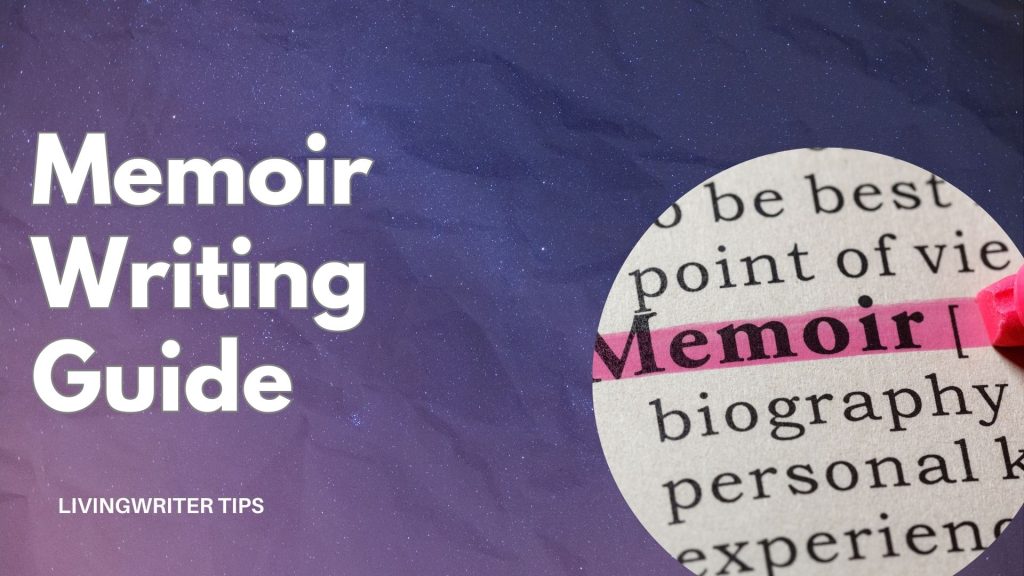
Many people have thought about writing their life story into a book. People want to tell their stories because storytelling is a part of human nature, and no story is more personal to us than our own. That said, it’s hard to know where to start and how to finish your life story in a way people want to read. Today, I’ll be covering everything you need to know about how to write a memoir of your life.
To write a good memoir, you’ll need to figure out which parts of your life are most important to the story your telling, organize them, and then write them in a structured way that is entertaining and egaging to readers from start to finish, just like you would a novel.
Yep. Unfortunately, there is no way around solid writing, even when you’re writing a book about your own life. But don’t worry; I’ll give you the tips for success. I’ll cover how to know if your story is interesting enough to be a memoir, how to navigate sensitive family issues when writing, and finally, five books I recommend you read if you want to write a memoir. So, let’s get started.

Table of Contents
What is a memoir.
Let’s start with the basics, just so we’re all on the same page. A memoir is autobiographical writing that focuses on a particular aspect of the author’s life. It often explores a specific theme, event, or period and allows you to reflect on your personal experiences and growth. Think of this as a more detailed, zoomed-in look at particular parts of your life.
Memoirs can be written in various styles, from formal and academic to informal and conversational. While they usually don’t tell your entire life from start to finish, they typically aren’t short and can reach full novel length.
Key characteristics of a memoir:
- Personal narrative: Memoirs are deeply personal accounts of your life.
- Focused theme: They often explore a specific theme or event, such as overcoming adversity, finding love, traveling to a new place, grief, etc.
- Reflection and growth: Memoirs allow you to reflect on certain experiences and how they have shaped you.
- Subjective perspective: Memoirs are written from your subjective point of view, offering your unique and personal interpretation of events.
What Is An Autobiography?
An autobiography is a more comprehensive account of your life. It covers all aspects of your life, from childhood to adulthood, and includes all significant events, relationships, and achievements and is written in chronological order.
Autobiographies are usually written in a more formal style than memoirs and aim to provide a complete and more objective telling of your life story from the start to your current point in life.
Key characteristics of an autobiography:
- Comprehensive coverage: Autobiographies give a full look at your entire life, including childhood, education, career, etc.
- Objective tone: While autobiographies are written from your perspective, they often have a more objective and factual tone.
- Chronological order: Autobiographies are typically organized chronologically, following the sequence of the author’s life events.
Autobiography Vs. Biography
While both autobiographies and biographies focus on a person’s life, there are a few key differences. An auto biography is written by the person whose life is being described. So, you’re writing about your own life, while a biography is when someone writes someone else’s life story.
Here are a few other differences between the two that are worth mentioning:
- Perspective: Autobiographies offer a first-person perspective, while biographies provide a third-person perspective.
- Scope: Autobiographies typically cover your entire life, while biographies may focus on a specific aspect or period.
- Objectivity: Biographies are generally more objective than autobiographies, as they are written by someone outside of the subject’s life.
Memoir Vs. Autobiography – Which Should You Write
The key difference is the level of detail and the focus of the narrative. Autobiographies aim to provide a comprehensive overview of one’s life, while memoirs often focus on a more specific theme or series of events.
The choice between the two depends on your circumstances and the story you want to tell. Here are some factors that may influence this choice:
- Scope of experiences: If you have a wide range of interconnected experiences that contribute to a coherent narrative, an autobiography may be the best choice. However, a memoir can be more effective if the focus is on a specific theme or event(s).
- Depth of exploration: Memoirs often allow for a deeper exploration of a particular aspect of your life, while autobiographies provide a broader overview.
- Target audience: The intended audience may also influence the choice between memoir and autobiography. For example, a story aimed at a specific niche audience (say, dealing with personal loss) would do best as a memoir.
For example, Benjamin Franklin’s autobiography is a classic example of a comprehensive life story. He begins with his humble beginnings and tells his rise to prominence as a statesman, scientist, and inventor. The breadth of his experiences and achievements makes it necessary to tell his entire life story to provide a complete picture of his journey.
Elie Wiesel’s memoir “ Night ” is an account of his experiences in concentration camps during the Holocaust. While it is a deeply personal narrative, it does not require a complete life story to be effective. Instead, it limits the scope to focus on specific experiences and their lasting impact on his life.
How To Write A Memoir
Ok, you’ve decided to turn your life story into a book, specifically a memoir. What now? How do you write a memoir? Well, the short answer is, “Much like you would a novel.” Aside from knowing the plot and the “characters” ahead of time, the goal is the same – Tell your story in an entertaining and engaging way that readers want to read.
I want to mention that many people find great value in writing their stories, even if they never intend to publish, share, or sell them. If that is the case, I 100% encourage you to put pen to paper. And if you’re telling the story for yourself, you can focus a little bit less on the technical side of the craft.
For everyone else, if you want other people to read and enjoy your memoir, it will have to be well-written, well-paced, maintain some tension, and have conflict and resolution, just like a fiction novel would. So, below, I’ll cover these technical aspects as well as how to get your life’s events organized and ready for the page.
How To Start Writing A Memoir?
Many people struggle with where to start telling their stories. The “100 Moments” exercise opens you up and gets your most important ideas out. To do this, you’ll sit down with a pen and paper (I do recommend you physically write these out) and list 100 moments from your life.
To start, set aside 20 to 30 minutes to write. The time frame is important because this is a free-thinking exercise. You kinda want to sit down and write what comes to mind without thinking about it too much. It may take a while to get all 100 down, but you definitely want to set that 30-minute cap so you don’t overthink.
You don’t have to include everything you write on the page in the memoir. This is simply to “mine out” some of the more standout moments. That said, they don’t all have to be huge things. Simple things like smells and vibes are ok, as are incomplete thoughts. However, you do want specific moments whenever possible.
For example, “the smell of my childhood basement” may be something that comes up. And that’s great. If possible, tie it to a memory of being in the basement. That way, if you include it in the book, you’ll have a little bit more to work with.
Is Your Story Good Enough To Be A Great Memoir?
Many wonder if their life is interesting enough for a book. And it’s a good question to ask. After all, most of us aren’t celebrities. And, of course, the things that have happened to you will be most important to you . It’s also common to have support from those close to you… But will strangers find your life as impactful as you do?
I’ve got good and bad news. In general, the telling is more important than the story. If you can write well, even simple things like your happy marriage can be something people want to read. So, yes, your story can likely make a good memoir, regardless of what it is, provided you can write it well.
As mentioned above, your goal is important. If you have no writing experience, it’s going to be a stretch to write a best-seller on your first try. To sell books , you must work on your technical writing and write a good story.
However, the journey is the goal for many people; if it’s important to you, write it regardless. If you don’t care about selling books or even sharing your work, just write the story that you are compelled to tell.
How To Write A Memoir People Want To Read
A memoir is a unique writing experience. Unlike fiction, you don’t need to invent characters or plots. You’ve probably also got some natural progression from beginning to middle and end and some natural conflict. However, you’ve still got to present them in a cohesive, entertaining way.
Here are five things that you’ll want to consider:
1. Story Structure
Story structure dictates how your story unfolds and at what pace. This is crucial for keeping your reader engaged throughout the story. As I said, memoirs aren’t short works, and it can take hours upon hours for a reader to finish your book. A well-paced story will maintain tension and keep them reading, while a lack of structure means they likely won’t finish the book.
The Three-Act Structure
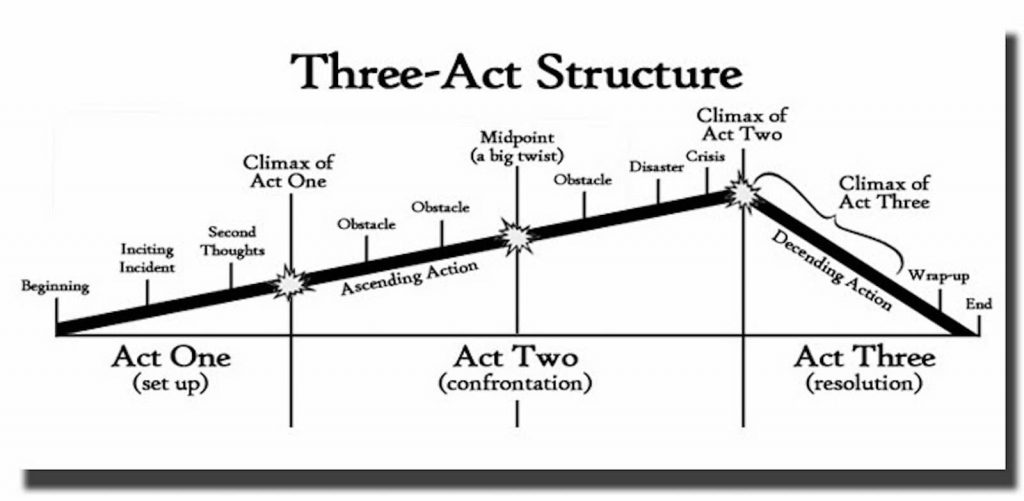
The three-act structure is probably the most common storytelling framework and is used in various forms of media, including novels, plays, and films. It divides a story into three main parts:
- Introduces the main characters and their world.
- Establishes the initial conflict or problem.
- Sets up the story’s stakes and goals.
- The conflict intensifies, and the stakes are raised.
- Characters face obstacles and challenges.
- The story builds towards a climax.
- The climax occurs, resolving the main conflict.
- The characters face the consequences of their actions.
- The story concludes with a sense of closure.
While this is a general outline, the three-act structure can be adapted to fit your memoir’s unique story and themes. The key is to ensure that the narrative has a clear beginning, middle, and end and that the conflict and character development are well-structured.
For a deeper dive into the three-act structure, click here: Screenplay Structure: Tips to Engage Audiences .
LivingWriter Outlines
Perhaps the easiest way to outline your memoir is to write with LivingWriter . There are devoted outlines for memoirs, including several subgenres.

This outline will apply the three-act structure mentioned above directly to your manuscript, which you will then fill in with your chapters.
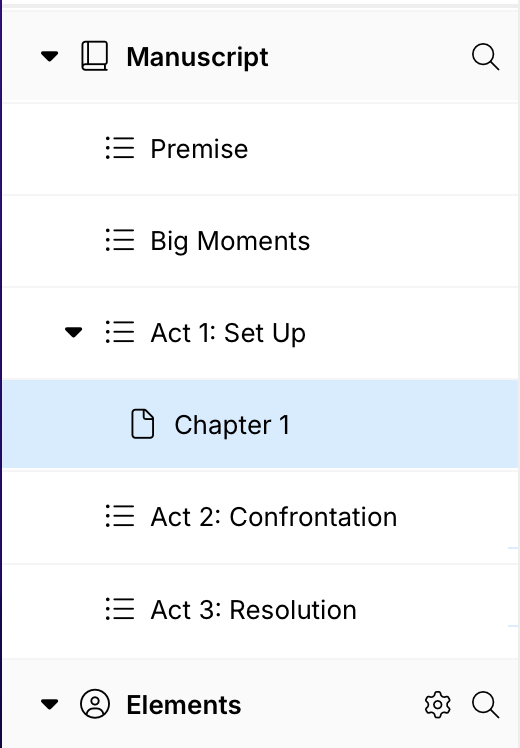
AI Outlines
However, you can take things a step farther, and use a LivingWriter AI Outline too. An AI outlines give you a complete framework to build your story within. With a general description of your story and the click of a button, it can generate a manuscript summary with all your crucial plot points and important people.
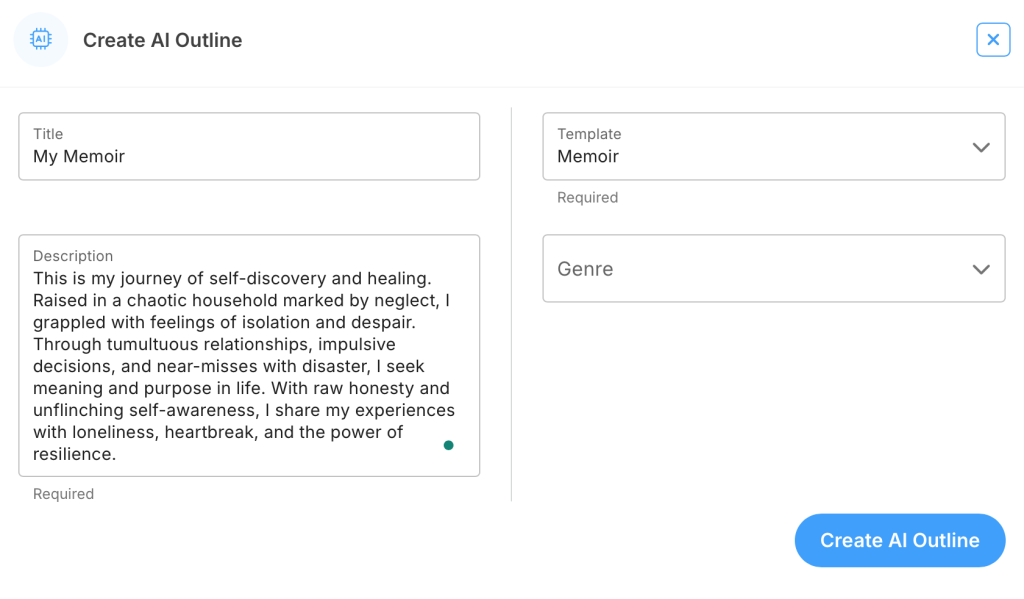
The dropdown “genre” bar allows you to get a little more specific with what theme or sub-genre you’re doing with your story. Here are the options you have:
- Self-Help/Personal Development
- Motivational/Inspirational
- Health & Fitness
- Families & Relationships
- Humor & Entertainment
- Business & Money
- Law & Criminology
- Politics & Social Sciences
- Religion & Spirituality
- Education & Teaching
After you’ve picked your genre, you’ll be given a preview of the outline. Here is a look at a preview from my example above, which used the “Families & Relationships” genre:
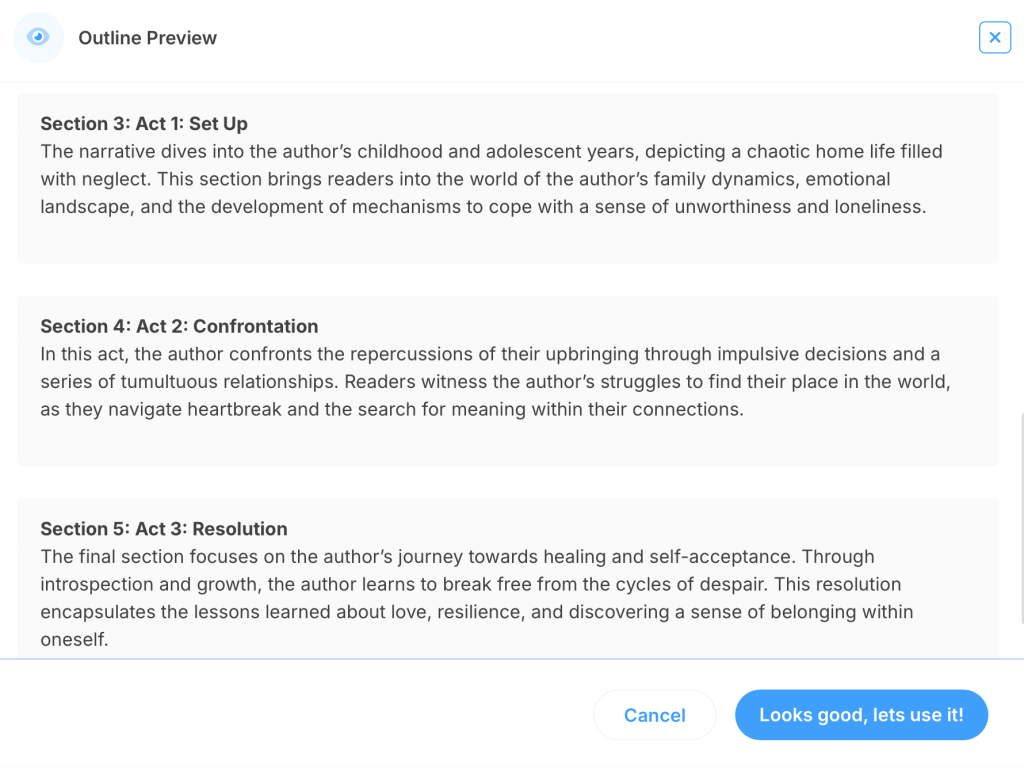
As you can see, the AI outlines provide a lot of additional guidance for what information should go in particular sections of the story. This makes it easier than ever to use high-level story structures within your work without having to overthink things. And best of all, despite being an AI feature, it doesn’t do any of the writing for you.
2. Show, Don’t Tell
We’ve all got that one friend who can tell you about what happened at work that day and tell an entertaining story. Just because your story isn’t fiction doesn’t mean it should be plain. Use descriptive language to paint a picture in the reader’s mind.
You May Also Like: 12 Common Beginner Writing Mistakes You Must Avoid
For example, Instead of saying, “She was very angry,” you could write, “Her face flushed red, and her fists clenched as she slammed the door.” The second sentence shows the character’s anger through her actions and emotions rather than simply telling the reader that she is angry.

When people think dialogue, they think fiction. However, even in a memoir, dialogue can reveal personalities and add depth and authenticity to your story. It can also help to advance the plot and create tension.
What people say and how they say it goes a long way in showing the reader who they are and how they think and feel. It can also advance the story by providing information and fueling conflict without having to information dump readers.
When writing dialogue, it’s important to use natural-sounding language and avoid clichés. I highly suggest you check out my article How To Write Dialogue In A Story for a deep dive into what dialogue is, its purpose in storytelling, and how to do it well.
3. Strong Voice
A memoir, is your experiences, told by you. So, naturally, you’ll want to embrace your voice and style in your writing. If you don’t write often, I suggest just telling the story in whatever way is the most natural. In other words, it shouldn’t be plain, but you don’t want it to be unnaturally flowery or disengenous to yourself.
There is no set, one-size-fits-all voice that you should strive for. Instead, my advice is to be as authentic as you can when telling your story and stick to what you’re doing. In other words, be real and consistent, and your readers will thank you.
4. Conflict And Tension
Building conflict and maintaining tension throughout your story is a critical component of success. In general, this will come down to external conflict (the obstacles you encountered in your life), internal conflict (your internal dilemmas related to those obstacles), and rising stakes.
My favorite way to make sure you’ve done this is through establishing clear “wants” and “needs.” A “want” is what a person wants to achieve throughout the story. This want usually drives the plot of the story from start to finish.
On the other hand, the “need” is the underlying factor that the person needs to navigate in order to get what they want, grow as a person, and be fulfilled. The need will often represent the theme and emotional aspect of the story.
When you consciously have both of these elements present, and your structure/pacing is good, you should have no problem building and keeping a reader’s attention throughout your book.
5. Theme And Message
As mentioned above, once you establish the wants and needs of the main people in your story, you will probably have a good idea of the themes and messages underlying your story. If not, you’ll probably want to ask yourself what messages you want to convey with your story.
Once you do, dig into what audiences the theme would best resonate with and keep them in mind as you write the story. A word of caution, though: avoid being overly preachy and let the theme take form naturally and subtly.
Handling The Sensitive Stuff
Let’s talk about the elephant in the room for many people wanting to write a memoir – People in your family may not like what you have to say. You’re telling your side of the story, and sometimes, that will be very different from what other people remember.
Plus, there’s a good chance you’ll be viewed as giving up all the dirty laundry. What will Grandma, Mom, and Dad think, especially if you paint them in a bad light? There’s also a good chance they may learn things about you (or others) that they didn’t know before.
If you value how they feel or what they think, you probably don’t want them mad at you. So, what do you do? I suggest you write your story as you see it and be truthful. That’s the only way to write. However, after you write it, maybe don’t publish it if it contains things you would rather not have others read.
You May Also Like: How To Get A Book Published: Guide to Agents, Editors & More
The first draft should be 100% your story. But you can write it and see what happens. This removes the pressure of what will happen with your family unit and allows you to write what you need. Perhaps you’ll find that your fears and discomfort were things you’ve been holding onto without cause and feel comfortable publishing after all.
If not, you can always refrain from publishing or even edit certain parts later. However, if you do decide to publish some hard-hitting or accusatory material, I suggest you talk to a lawyer to ensure that your language works and avoid anything that could be considered defamatory or harmful.
Best Books About Memoir Writing

As with any literary genre, books written by experts can be invaluable resources for learning how to write a memoir. Here are five books that cover various aspects of memoir writing. They are:
“The Book You Were Meant to Write” by Kelly Notaras”
Notaras, a writing coach and author, provides a very practical guide to writing a memoir. She offers advice on everything from finding your story to overcoming writer’s block. The book is quite clear concise, and easy to follow and understand. I find her emphasis on finding your unique voice and telling your story with passion is particularly valuable for aspiring memoir writers.
“Your Story” by Joanne Fedler
Joanne Fedler is a writing teacher and coach. Her book, Your Story offers a step-by-step approach to writing a memoir. She covers character development, plot structure, and finding your theme. The structured approach can be helpful for writers who need guidance and support throughout the writing process.
“Shimmering Images” by Lisa Dale Norton
In “Shimmering Images,” Norton talks about the power of imagery and metaphor in memoir writing. She offers practical exercises and advice on using vivid language to bring your story to life. If you struggle to create an immersive and engaging reading experience, you’ll find this a big help.
“Still Writing” by Dani Shapiro
Dani Shapiro is a successful bestselling memoirist who reflects on her journey as a writer and offers advice on overcoming challenges and finding inspiration. Her honesty is an excellent source of motivation for aspiring memoir writers.
There you have it, my friends. Everything you need to know about how to write a memoir. From being sure your life story is good enough to be a memoir, to getting started and the more technical aspects of writing that will make others want to start your book and be unable to put it down.
With LivingWriter outlines and AI tools, there has never been a better time to turn your life story into a book. So, the only thing left to do is sit down, do the “100 moments” exercise, and start writing. Until next time, take care of yourselves, and happy writing.
- Writing Tips
- Travel Writing
- Try LivingWriter

Home » Writing » Autobiography vs. Biography vs. Memoir


Autobiography vs. Biography vs. Memoir
The three primary formats of a memory book , used to tell a life story, are a biography, an autobiography, and a memoir. Distinguishing between the three can feel a bit confusing since they all share several similarities. But there are some distinct differences.
Simply put, a biography is the life history of an individual, written by someone else. An autobiography is the story of a person’s life, written by that person. And a memoir is a collection of memories written by the person themselves.
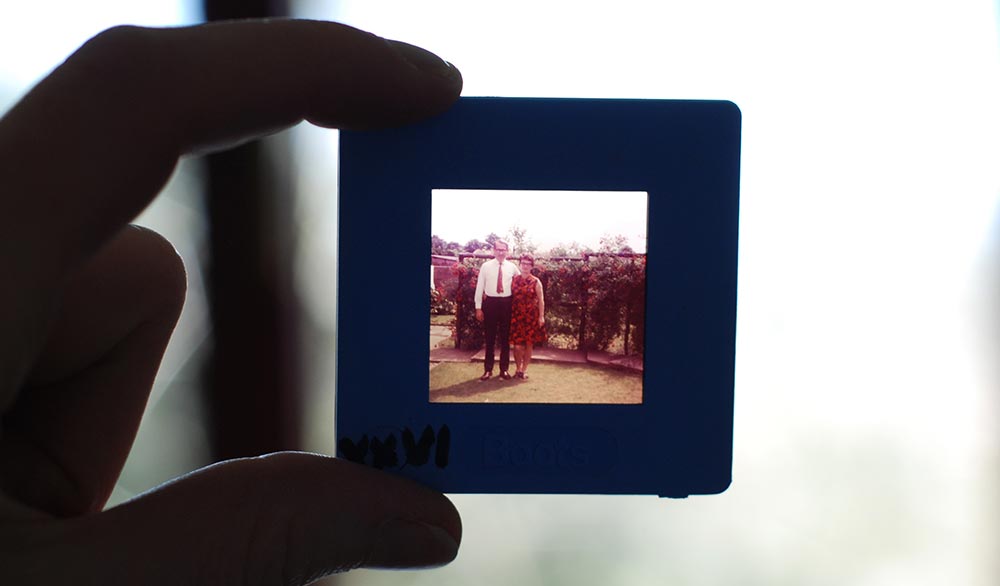
What is a Biography?
A biography, also called a bio, is a non-fiction piece of work giving an objective account of a person’s life. The main difference between a biography vs. an autobiography is that the author of a biography is not the subject. A biography could be someone still living today, or it could be the subject of a person who lived years ago.
Biographies include details of key events that shaped the subject’s life, and information about their birthplace, education, work, and relationships. Biographers use a number of research sources, including interviews, letters, diaries, photographs, essays, reference books, and newspapers. While a biography is usually in the written form, it can be produced in other formats such as music composition or film.
If the target person of the biography is not alive, then the storytelling requires an immense amount of research. Interviews might be required to collect information from historical experts, people who knew the person (e.g., friends and family), or reading other older accounts from other people who wrote about the person in previous years. In biographies where the person is still alive, the writer can conduct several interviews with the target person to gain insight on their life.
The goal of a biography is to take the reader through the life story of the person, including their childhood into adolescence and teenage years, and then their early adult life into the rest of their years. The biography tells a story of how the person learned life’s lessons and the ways the person navigated the world. It should give the reader a clear picture of the person’s personality, traits, and their interaction in the world.
Biographies can also be focused on groups of people and not just one person. For example, a biography can be a historical account of a group of people from hundreds of years ago. This group could have the main person who was a part of the group, and the author writes about the group to tell a story of how they shaped the world.
Fictional biographies mix some true historical accounts with events to help improve the story. Think of fictional biographies as movies that display a warning that the story is made of real characters, but some events are fictional to add to the storyline and entertainment value. A lot of research still goes into a fictional biography, but the author has more room to create a storyline instead of sticking to factual events.
Examples of famous biographies include:
- His Excellency: George Washington by Joseph J. Ellis
- Einstein: The Life and Times by Ronald William Clark
- Princess Diana – A Biography of The Princess of Wales by Drew L. Crichton
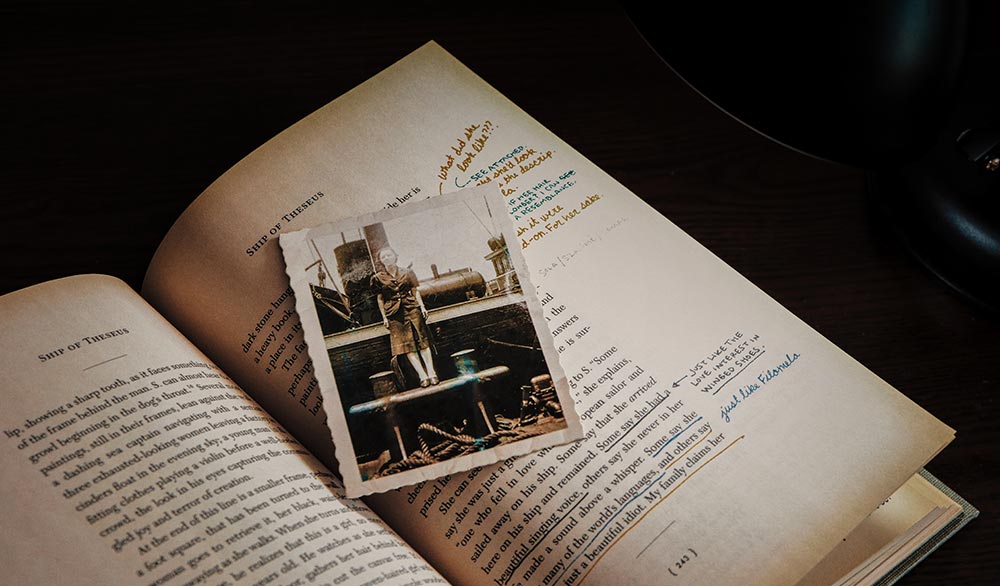
What is an Autobiography?
An autobiography is the story of a person’s life written by that person. Because the author is also the main character of the story, autobiographies are written in the first person. Usually, an autobiography is written by the person who is the subject of the book, but sometimes the autobiography is written by another person. Because an autobiography is usually a life story for the author, the theme can be anything from religious to a personal account to pass on to children.
The purpose of an autobiography is to portray the life experiences and achievements of the author. Therefore, most autobiographies are typically written later in the subject’s life. It’s written from the point of view of the author, so it typically uses first person accounts to describe the story.
An autobiography often begins during early childhood and chronologically details key events throughout the author’s life. Autobiographies usually include information about where a person was born and brought up, their education, career, life experiences, the challenges they faced, and their key achievements.
On rare occasions, an autobiography is created from a person’s diary or memoirs. When diaries are used, the author must organize them to create a chronological and cohesive story. The story might have flashbacks or flashforwards to describe a specific event, but the main storyline should follow chronological order from the author’s early life to their current events.
One of the main differences between an autobiography vs. a biography is that autobiographies tend to be more subjective. That’s because they are written by the subject, and present the facts based on their own memories of a specific situation, which can be biased. The story covers the author’s opinions on specific subjects and provides an account of their feelings as they navigate certain situations. These stories are also very personal because it’s a personal account of the author’s life rather than a biography where a third party writes about a specific person.
Examples of famous autobiographies include:
- The Story of My Life by Helen Keller
- The Diary of a Young Girl by Anne Frank
- Losing My Virginity by Richard Branson
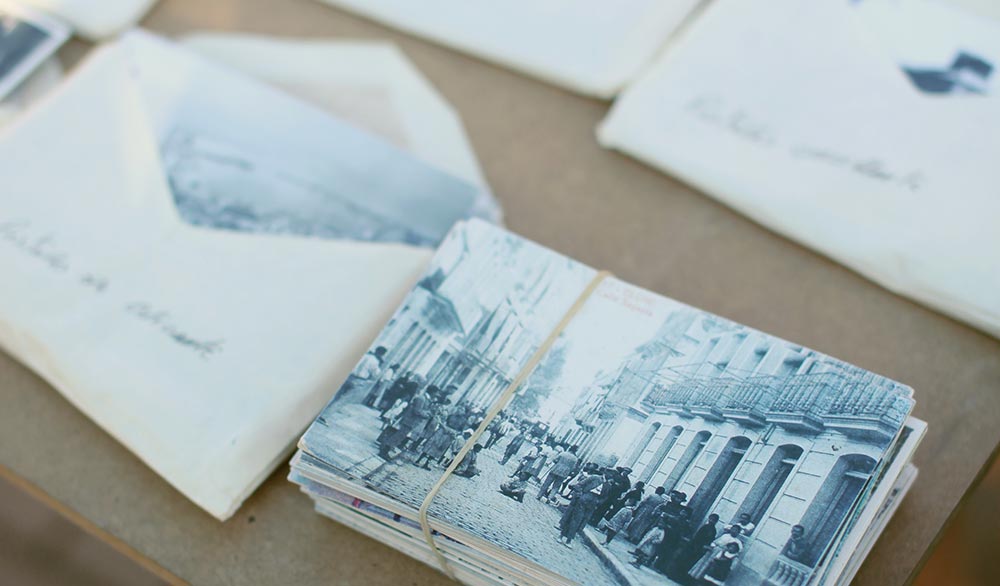
What is a Memoir?
Memoir comes from the French word mémoire , meaning memory or reminiscence. Similar to an autobiography, a memoir is the story of a person’s life written by that person. These life stories are often from diary entries either from a first-person account or from a close family member or friend with access to personal diaries.
The difference between a memoir vs. an autobiography is that a memoir focuses on reflection and establishing an emotional connection, rather than simply presenting the facts about their life. The author uses their personal knowledge to tell an intimate and emotional story about the private or public happenings in their life. The author could be the person in the story, or it can be written by a close family member or friend who knew the subject person intimately. The topic is intentionally focused and does not include biographical or chronological aspects of the author’s life unless they are meaningful and relevant to the story.
Memoirs come in several types, all of which are written as an emotional account of the target person. They usually tell a story of a person who went through great struggles or faced challenges in a unique way. They can also cover confessionals where the memoir tells the story of the author’s account that contradicts another’s account.
This genre of writing is often stories covering famous people’s lives, such as celebrities. In many memoir projects, the celebrity or person of interest needs help with organization, writing the story, and fleshing out ideas from the person’s diaries. It might take several interviews before the story can be fully outlined and written, so it’s not uncommon for a memoir project to last several months.
Memoirs do not usually require as much research as biographies and autobiographies, because you have the personal accounts in diary entries and documents with the person’s thoughts. It might require several interviews, however, before the diary entries can be organized to give an accurate account on the person’s thoughts and emotions. The story does not necessarily need to be in chronological order compared to an autobiography, but it might be to tell a better story.
Examples of famous memoirs include:
- Angela’s Ashes by Frank McCourt
- I Know Why the Caged Bird Sings by Maya Angelou
- Personal Memoirs of Ulysses S. Grant by Ulysses S. Grant
Autobiography vs. Biography vs. Memoir Comparison Chart
Check out some of our blogs to learn more about memoirs:
- What is a memoir?
- 5 tips for writing a memoir
- Your memoir is your legacy
Ready to get started on your own memoir, autobiography, or biography? Download our free desktop book-making software, BookWright .
Autobiographies , Biographies , memoirs
This post doesn't have any comment. Be the first one!
This is a unique website which will require a more modern browser to work! Please upgrade today!
This is a modern website which will require Javascript to work.
Please turn it on!
- Expert Publishing Services
- 917-922-1339
- [email protected]
Autobiography vs. Biography vs. Memoir: Differences of Each Type

How to Outline a Novel Before You Start Writing

The Best Way to List and Sell Your Book on Amazon
- autobiography

Do you ever get confused when trying to differentiate between an autobiography, biography, and memoir? If so, you’re not alone—these three genres are often used interchangeably, but each one actually requires its own unique approach. In this blog post, we’ll discuss the differences of each type and provide some handy tips on how best to write them all!
Introducing the different genres of writing—autobiography, biography, and memoir
Three genres that often get jumbled together are autobiography, biography, and memoir. While they may seem similar at first glance, each genre has its own unique characteristics. An autobiography, for example, is a first-person account of someone’s life, typically written by the subject themselves. A biography, by contrast, is a third-person account of someone’s life, written by someone else. And a memoir is a focused, often thematic account of a particular period or experience in someone’s life. Knowing the distinctions between these genres can help you decide which approach is best for telling your own story or for crafting a compelling biography or memoir.
Understanding the differences between autobiography, biography and memoir
Autobiography, biography, and memoir are often confused with each other. An autobiography is a book written by the author about their own life experiences. In contrast, a biography is a book written by someone else about another person’s life experiences. Finally, a memoir is a book written about a specific time or event in the author’s life. These three genres require different approaches to writing and reading. Autobiographies are generally more personal, while biographies generally intend to provide a more objective view of a person’s life. Memoirs allow for a deeper exploration of a specific period of time or event.
Exploring the benefits of writing an autobiography
Writing an autobiography can serve as a time capsule for one’s life experiences and also act as a vehicle for personal growth and self-reflection. Through the process of writing, individuals have the opportunity to gain a deeper understanding of themselves. Additionally, an autobiography can be an invaluable resource for future generations by providing them with a window into the past and the inner workings of their ancestors. If you’re looking for a way to capture your life story and leave a meaningful legacy, writing an autobiography might be a good idea.
Discovering the advantages of writing a biography
A biography records the life and accomplishments of a person. A biography can provide insight into the individual’s beliefs, accomplishments, and experiences that shaped their life. Writing a biography requires research , attention to detail, and a thorough understanding of the individual’s life. It takes time and effort. By capturing a person’s story in writing, we can learn from their life experiences and be inspired to pursue our own passions and dreams. Writing a biography can be challenging, but the end result is a rewarding tribute to a person.
Examining the unique aspects of writing a memoir
Writing a memoir is an incredible way to tell your story and leave a lasting legacy. What makes a memoir unique is that it is not just about recounting facts or events. It is more so about exploring the deeper meaning and emotions behind those experiences. It requires a delicate balance of vulnerability and objectivity, as you must be willing to share personal details while also maintaining a sense of clarity and purpose. To truly connect with your audience, it is important to infuse your writing with your own voice and personality, making the story feel authentic and relatable.
Making efficient use of resources when writing your story
Making an efficient use of resources will help create a compelling story that resonates with readers. Whether it’s time management, research, or even word choice, every decision plays an integral role in crafting a well-structured narrative. One useful tool for maximizing your efficiency is outlining your story beforehand, allowing you to flesh out characters and plot points in a clear and concise manner. Additionally, don’t be afraid to take advantage of resources such as writing groups, online tutorials, and feedback from industry professionals who can provide valuable perspective and insight into your work.
As you now know, autobiographies, biographies, and memoirs each have their own unique focus, purpose, and advantages. Writing your life story can be rewarding and fulfilling. Having a writing partner experienced with these genres to guide you on your journey can be invaluable in producing the story you want to tell. If it is time to tell your story―whether fact or fiction―contact Elite Authors today! We will help you choose the genre that best fits your project goals while helping you craft a stunning personal account that is sure to capture the imagination of readers everywhere.
Related posts

Solidifying Your Position as a Thought Leader

How to Make Time to Write a Business Book

What Is a Title Page?
Need help moving your files from createspace to kdp, let us help you move your book for free..
Autobiography vs. Biography vs. Memoir: What’s the Difference?
This post may contains affiliate links. If you click and buy we may make a commission, at no additional charge to you. Please see our disclosure policy for more details.
Autobiographies, biographies, and memoirs. These are the three main formats that tell a real person’s life story.
But unless you’re in the know, it can be a little confusing to tell the difference between each one. While they all serve a similar purpose, they each have distinctions that set them apart from one another.
In this post, I’ll explain the differences between autobiographies, biographies, and memoirs. And to clear up any confusion, I’ll provide some famous examples of each one.
Table of Contents
Autobiography vs. Biography vs. Memoir
Autobiographies.
An autobiography is an account of a person’s life, written by that person. The word originates from the Greek’ auto’, ‘bios’ and ‘graphein’, meaning ‘self,’ ‘life,’ and ‘to write.’
Since the narrator is also the subject of the story, autobiographies tend to be written in the first person.
The majority of autobiographies begin by documenting childhood experiences, working their way chronologically upwards through the decades. The author will include major and minor events that have shaped their lives and stood out to them on their journey.
A detailed autobiography will cover things like a person’s earliest memories, early family life, and upbringing. They might share stories from their education, their careers, and their relationships, as well as triumphs and challenges they’ve faced along the way.
Since an autobiography is a life story, most people wait until their later years before they pen their own, but this isn’t always true. There are plenty of autobiographies written by younger people too. Anyone that has led an interesting life can write an autobiography.
Here’s a few examples of autobiographies written by famous people:
- Autobiography of Benjamin Franklin by Benjamin Franklin
Benjamin Franklin wrote his autobiography from 1771 to 1790. It tells the fascinating tale of his rise to power, from a boy born into a lower-middle-class family in Boston, Massachusetts, to becoming one of America’s founding fathers.
- Mein Kampf by Adolf Hitler
Adolf Hitler’s autobiography Mein Kampf, meaning ‘my struggle,’ gives us a raw and eye-opening look into the unseen life of this mass-murdering dictator. It’s not an easy or lighthearted read by any means. Still, it gives the reader a fascinating insight into his early life, his rise to power, and his own justifications behind his monstrous genocidal policies.
- The Diary of a Young Girl by Anne Frank
This is a more unusual example of an autobiography, but it’s an autobiography non the less. Ann Frank’s real-life diary documents her experience as a Jewish teenager who was forced into hiding during World War II.
Biographies
Just like an autobiography, a biography tells a person’s life story. But in this case, it is written by another author, rather than the person themselves.
Biographies are most often written about famous, notable people who have led interesting lives. They usually include factual details, such as their birthplace, their education, their partners and relationships, and facts about their career.
But a good biography will also cover how key events have shaped a person’s life. Biography authors will compile information from a wide range of sources, including interviews with the person in question or their friends, colleagues, and family members. They may also source information from letters, diaries, past interviews, and periodicals.
Here are a few examples of famous biographies:
- Churchill: A Life by Martin Gilbert
Many authors over the year have written biographies about his iconic British prime minister. Still, it’s Martin Gilbert’s work which has been by far the most successful and celebrated.
Through years of in-depth research, Gilbert gives readers a comprehensive and honest insight into the life of the man who led Britain through the Second World War.
- Frida: Biography of Frida Kahlo by Hayden Herrera
Hayden Herrera wrote this eye-opening biography of celebrated painter Frida Kahlo back in 1983, and it has since become the most authoritative account of her life in print.
The book documents Kahlo’s struggles and pain, but it also tells of her artistic prowess and her determination to leave a positive influence on the world.
- Sylvia Plath and Life Before Ted by Andrew Wilson
Rather than focusing on Sylvia Plath’s painful struggles with mental health and her turbulent marriage to English poet Ted Hughs, this biography tells of Plath’s earlier life, before the pair ever met. Taking information directly from her detailed diary entries, Wilson has complied an insightful picture of the American writer’s early experiences before she found fame.
Taken from the French word for ‘memory,’ a memoir is a non-fiction, self-written account of a person’s life. But unlike an autobiography, a memoir focuses much more on the emotional journey rather than chronologically recounting facts and events.
Memoirs are essentially a collection of memories that are important to the author, and they paint an intimate portrait of what it was like to be in their shoes.
Due to the similar nature of memoirs and autobiographies, it’s sometimes hard to denote the difference between the two, especially in the modern era when genres are often blended, and new ways of writing become commonplace.
One key thing to remember is that a memoir is usually less of a timeline of events and more an informal, emotional picture of a person’s life. Memoirs will often focus on things like past regrets and life lessons learned along the way, whereas autobiographies concentrate on facts and things that happened.
Here are a few examples of famous memoirs:
- I Know Why the Caged Bird Sings by Maya Angelou
The American writer and civil rights activist Maya Angelou wrote a total of seven autobiographies and memoirs during her lifetime, but this is the most notable one of them all.
This famous memoir documents the first seventeen years of her life as a young African American woman, and all of the struggles and turmoils she faced and overcame during that time.
- Eat Pray Love by Elizabeth Gilbert
This travel memoir written by the New York Times best-selling author Elizabeth Gilbert was subsequently turned into a blockbuster movie starring Julia Roberts.
It documents Gilbert’s personal journey of rebirth following a painful divorce and invites the reader to share the valuable and life changing lessons she learns along the way.
- Angela’s Ashes by Frank McCourt
Frank McCourt’s moving memoir takes us on an in-depth journey through his childhood years when he lived a profoundly impoverished life in Ireland during the midst of the Great Depression.
It won a 1997 Pulitzer Prize and has also been adapted to the silver screen.
Autobiographies, biographies, and memoirs all do one job: they tell a person’s non-fictional life story. But as you can see, each one is unique in its own way.
Do you have a favorite autobiography, biography, or memoir?
Let us know in the comments below.
Check out these other great articles!
- 7 Essential Tips for Writing Poetry
- The Best Note Taking App for Writers
- 6 Tips for Writing Creative Non-Fiction
- 11 Extraordinary Stephen King Writing Tips
- 6 Tips for Writing a Book All Writers Must Know
Leave a Comment Cancel reply

IMAGES
COMMENTS
A memoir is a nonfiction narrative in which the author shares their memories from a specific time period or reflects upon a string of themed occurrences throughout their life. An autobiography is a factual and historical account of one’s entire life from beginning to end.
However, a memoir can be more effective if the focus is on a specific theme or event(s). Depth of exploration: Memoirs often allow for a deeper exploration of a particular aspect of your life, while autobiographies provide a broader overview. Target audience: The intended audience may also influence the choice between memoir and autobiography ...
Discover the differences and similarities between an autobiography vs. biography vs. memoir. Learn what makes each format so special. The three primary formats of a memory book, used to tell a life story, are a biography, an autobiography, and a memoir.
In the literary world, first-person accounts are often categorized into two main genres: autobiography and memoir. Learn the key comparison points of a memoir and an autobiography, as well as tips for writing in both formats.
Autobiography, biography, and memoir are often confused with each other. An autobiography is a book written by the author about their own life experiences. In contrast, a biography is a book written by someone else about another person’s life experiences.
What's the difference between an autobiography, a biography and a memoir? We've got the answers, along with some real-life examples.